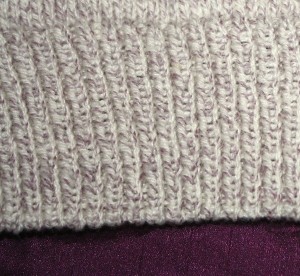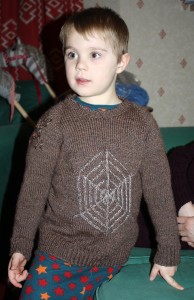Right, here is how to do a tubular cast on, I’ve been putting off writing it down because it involves a small amount of thinking but now I’m supposed to be doing some work updating the website so that is perfect motivation…
This cast on looks really nice – the knitting doesn’t really have an edge, it looks like it rolls underneath and goes up the back which is because you end up making a little hollow tube all the way along the bottom of the knitting. I think it looks really professional and since learning it I realised that most of my shop bought knitted clothes use this cast on and I never really noticed before. There are several ways to get the same effect and I reckon most of them look really complicated and fiddly but this method is really easy, it gives you 1×1 rib. (I think it may be possible to do something for a 2×2 rib but I haven’t tried that yet.)
Hopefully this is all ok, I’ve read it through a couple of times but if anybody spots any errors or needs any more clarification let me know.
You need a little piece of spare yarn, something thin and smooth like sock yarn is ideal and preferably in a colour that contrasts with what you are using for the knitting so you can see where it is to remove it afterwards. Also you should use needles that are two sizes smaller than you intend to use for the ribbing.

In the round (even number of stitches)
With your waste yarn cast on half the number of stitches needed for your pattern plus one (e.g. if you need 90 stitches, cast on 46) using whatever method you like.
Turn. Change to your main yarn.
Round 1: *K1, yo, repeat from* to last st, K1 (e.g.91 sts)
Join in the round – Make sure your stitches aren’t twisted and slip the first cast on stitch purlwise from the left to the right needle, place marker for beginning of round.
Round 2: * slip 1 purlwise with yarn in front, K1, repeat from * to last 2 sts K2tog (e.g. 90 sts)
Round 3: *P1, slip 1 purlwise with yarn in back, repeat from *
Round 4: * slip 1 purlwise with yarn in front, K1, repeat from *
Round 5: As round 3
Continue with larger needles in size for ribbing with P1, K1 rib for required number of rows.
Flat (odd number of stitches)
With your waste yarn cast on half the number of stitches needed for your pattern rounded up to the nearest whole number (e.g. if you need 91 stitches, 91/2 = 45 ½, cast on 46) using whatever method you like.
Turn. Change to your main yarn.
Row 1: *K1, yo, repeat from* to last st, K1 (e.g.91 sts)
Row 2: * K1, slip 1 purlwise with yarn in front, repeat from * to last st K1
Row 3: With yarn in front slip first stitch purlwise *K1, slip 1 purlwise with yarn in front, repeat from *
Repeat rows 2 and 3 once
Continue with larger needles in size for ribbing with K1, P1 rib for required number of rows.
Flat (even number of stitches)
With your waste yarn cast on half the number of stitches needed for your pattern plus one (e.g. if you need 90 stitches cast on 46) using whatever method you like.
Turn. Change to your main yarn.
Row 1: K2 *yo, K1 repeat from* to last st, K1 (e.g.90 sts)
Row 2: * K1, slip 1 purlwise with yarn in front, repeat from *
Repeat row 2 three times
Continue with larger needles in size for ribbing with K1, P1 rib for required number of rows
What you are actually doing is working half the stitches on one row and the other half on the next row so although you have worked four rows at the end of the cast on you will have the equivalent of two rows of knitting with half the stitches on the front and half the stitches on the back

Now either unpick the provisional cast on or cut it really carefully and remove it in sections, it is magic and the knitting won’t unravel. Scout’s honour.

Now you should have a lovely stretchy edge and no visible cast on. Oh, and it will look tiny until you’ve done a few more rows but it is super stretchy and will loosen up a little as you go along.
And I promise it won’t unravel, not that I was ever a scout but it really won’t. One time I tried to unravel something from the bottom, I can’t even remember why, maybe that end of the wool was easier to find or something but knitting just doesn’t unravel from the bottom up. All my happy childhood memories of cartoons where people got a thread snagged on something and then walked around and carried on oblivious to the fact that their jumper was merrily getting shorter and shorter were shattered. Until I learnt you can knit jumpers from the top down, in the round, like this one:


Hurrah for silly unravelly things! And I still have lots to learn about knitting.
The jumper is Julia Blake’s ‘Something Wicked This Way Comes‘ with a little added colour and extrapolated into a smaller size for Small (Hmmm, vague memory of GCSE statistics – extrapolation results are a bit hit and miss and not always a good idea – the sleeves are really too tight compared to the rest of the jumper, but never mind, he loves the spider…) Sorry the photos aren’t great, I didn’t know I was going to need a good one without pyjamas when I took it.



